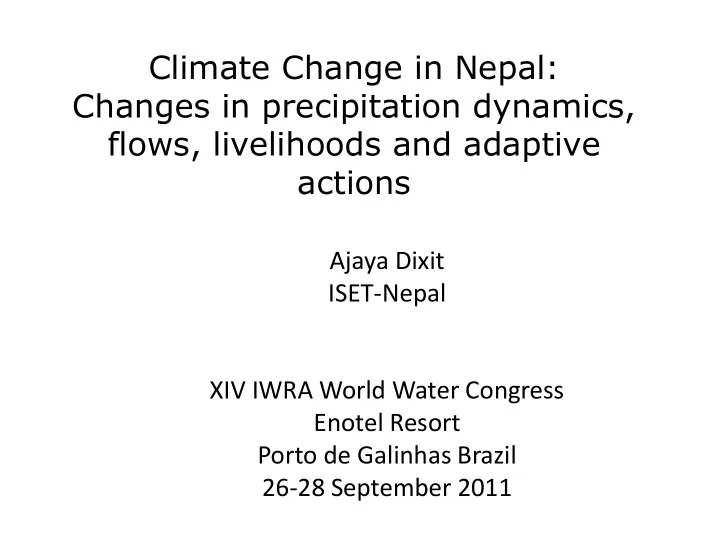

Climate Change in Nepal: Changes in precipitation dynamics, flows, livelihoods and adaptive actions Ajaya Dixit ISET-Nepal XIV IWRA World Water Congress Enotel Resort Porto de Galinhas Brazil 26-28 September 2011
Nepal in Himalaya Mountain System (HAM) Region of highland lowland complexity landscape climate interaction is complex Dramatic elevation changes
High mountains Middle hills Tarai Highly interlaced and interdependent social systems undergoing rapid changes
Rainfall variations at three scales
Water Resources: Spatial, temporal and social matrix Flow in billion m 3 River Types Name Basin % area population Annual Wet season Dry Season km 2 Total Snow Interflow, (J-J-A-S) groundwater Snow fed* Kosi 27,863 45 36** 9 ? ? 15 Gandaki 29,626 50 40 10 ? ? 21 Karnali 41,058 44 35 9 ? ? 10 Mahakali 5,317 6.21 5 1.1 ? ? 2 Non snow Kankai, 17,000 14.5 12*** 2,0 None Groundwater 23 fed seasonal Kamala, in pockets (has flashy Bagmati, trbutaries) Rapti, Babai Non snow Bering, 23,150 53 48**** 5 None Tarai has 30 fed (flashy) Trijuga, groundwater Ratu, Lal Bakaiya, Rohini, Banagang, Mohana etc. * Non-snow fed tributaries, ** 80 % monsoon flow , *** 85 % monsoon flow, **** 90 % monsoon flow
Karnali at Chisapani 5000 4000 3000 Monthly mean 2000 1000 0 May Mar. July Nov. Jan. Sep. West Rapti at Jalkundi 400 300 200 Monthly mean 100 0 Mar. May Nov. Jan. July Sep. Tinau at Dobhan 120 100 80 60 Monthly mean 40 20 0 May Mar. July Nov. Jan. Sep.
Climate change Annual Mean Temperature Trend (°C/year) 30 Temperature trend 29 28 27 -0.03 -0.02 -0.01 0 0.01 0.02 0.03 0.04 0.05 0.06 0.07 Scenario study suggests 80 81 82 83 84 85 86 87 88 temperature rise and precipitation Shrestha M. (2008) uncertainty Source NCVST, 2009 What are the vulnerabilities ?
LRMP (1984) Lower snow fall and changes in melt rates Impacts on livelihoods Will affect, high-land agriculture Very preliminary estimate puts about 35 % of Nepal’s population (more rigorous method needed) directly dependent on snow flow. Will affect tourism Will affect drinking water
2011 GLOF In Humla Source: ASTRID HOVDEN PhD fellow University of Oslo.
Localised loses of lives, assets, increased regional sedimentation (pulses) WECS, 1987 Lowered economic life of reservoirs Altered river behavior, lower performance of built system
Changes in regional hydrology Estimates of glacial melt to overall river flow varies from 2 to 20 percent Observed shifting of hydrograph of Kali Gandaki Shrestha, et al 2003 Will affect hydropower, irrigation, drinking water, groundwater systems and wetlands. Impact will ripple through systems
Challenges of middle hills and Tarai Subsistence farming Losses due to drought can be 50% of winter crop in some hill districts Already food deficit Migration is adaptation strategy, but global economy limiting factor More drying (Forest Fire) April 24, 2009 NASA
Extreme rainfall in hills Loss of lives, assets, livelihood and increased sedimentation, systemic effects Dixit 2003 (WECS, 1987 ) Floods in the Tarai
To sumamrise Snow and glaciers in the larger context A Local drinking water, irrigation etc Tourism Affects local livelihood B High GLOF potential Localises loses, increased regional sedimentation C Changes in regional hydrology due to changes in snow and glacier processes D Mid hills and Tarai challenges serious and equally important Loss of lives, assets, livelihoods and opportunities. Increased vulnerabilities Means focus on adaptation will be key
To the conceptual • If we define adaptation as planned responses to specific projected impacts, then specific climate-targeted responses are required. • If we define adaptation as an ongoing, evolutionary process within complex evolving systems, then approaches that address points of vulnerability within systems are important
Why ? • High levels of uncertainty in both local and regional climate changes, complex and poorly understood (IPCC “white” spot) • Limited data stations (placement, lack of resources: finances and human) • Adaptation to climate change embedded in dynamic socio- economic contexts with multiple change drivers -- much adaptation will be at autonomous level • Political incentives and governance mechanism vary greatly, and with them the ability to develop and implement “adaptive” strategies
Conclusions • Challenges of impacts of climate change on snow and glaciers needs to be viewed in the systemic context. • Enabling adaptation isn’t only about improving specific projections or planning specific strategies for responding to them. It is also about – understanding the levels of certainty in climate trends, tipping points and stress indicators – communicating uncertainty as well as certainty – building resilient systems (as gateways) that enable society to shift strategies and respond flexibly as conditions change -- linked with development – piloting and testing the systemic interventions that help planned and autonomous adaptation.
Thank you and jai hos (May you all be well)
Recommend
More recommend